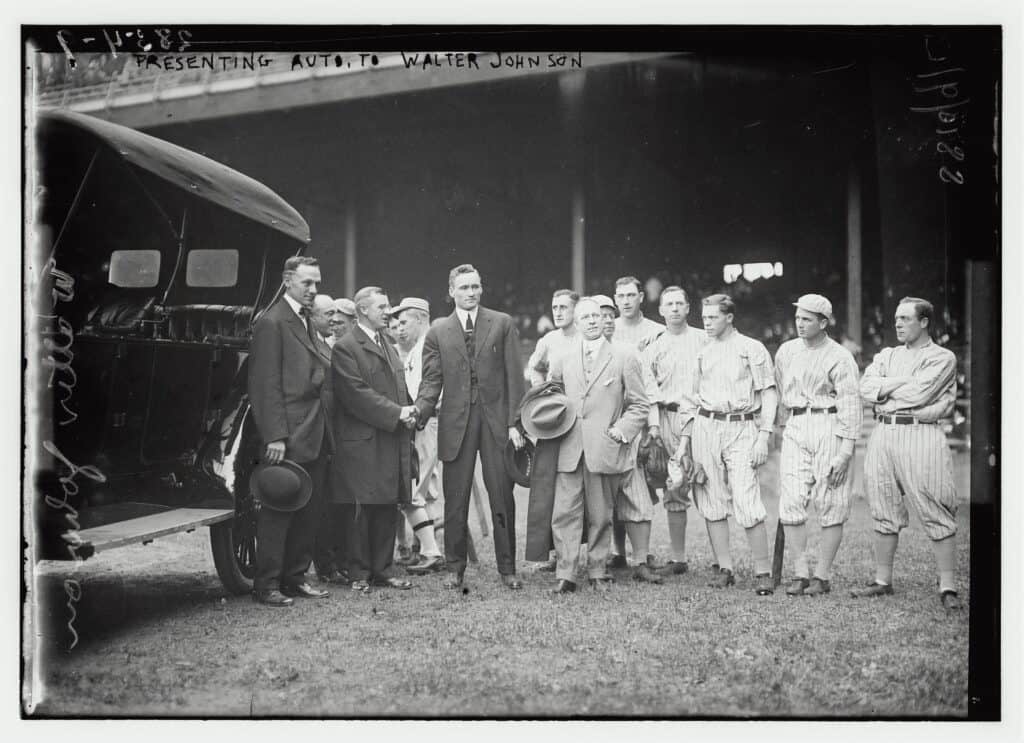Last Updated: January 20th, 2024 by Jake Cain
The Chalmers Award, granted between 1911 and 1914, holds a special place in baseball lore as one of the sport’s earliest accolades to celebrate exceptional performance. Introduced by Hugh Chalmers of the Chalmers Motor Car Company, it was awarded to the Major League Baseball player with the highest batting average at season’s end.
Not just a title, the award carried substantial clout and incentive by bestowing a brand-new Chalmers automobile upon the recipient, adding a luxurious spin to the honor of being named the season’s best batter.
Baseball, often revered as America’s pastime, has a long tradition of recognizing its stand-out athletes, yet the Chalmers Award predates many such honors still known today. Its short-lived existence marked a significant early intersection of sports and marketing, as the award effectively combined the competitive drive of baseball with the allure of the automotive industry—a rather savvy move for the times.
Although the award was discontinued after only a few years, it paved the way for future accolades, influencing the way professional achievements in baseball would be valued and celebrated in subsequent generations.
Origins of the Chalmers Award
This prestigious accolade in baseball history originated in 1910, intertwining the worlds of sports and business through an innovative marketing strategy.
Hugh Chalmers’ Vision
Hugh Chalmers, president of the Chalmers Motor Car Company, saw an opportunity in the burgeoning popularity of baseball. He aimed to boost his company’s profile through strategic advertising, marrying his brand with America’s favorite pastime.
Birth of the Prize
In 1911, Chalmers announced a prize that would go down in history: an actual automobile to the baseball player with the best batting average. It was an offering that would shift the nature of awards in baseball, connecting the sport with commercial promotion in a way never seen before.
Chalmers Award Winners and Controversies
The Chalmers Award, birthed from the union of baseball with the burgeoning automobile industry, served as an early template for MVP recognition in the Major Leagues. It was tinged with fierce competition and controversy, particularly involving figures like Ty Cobb and Nap Lajoie.
1910 Race to the Title
The 1910 batting title race came down to a photo finish between two baseball titans: Detroit’s Ty Cobb and Cleveland’s Napoleon Lajoie. Despite an eye injury, Cobb had a tight grip on the lead, sitting out the final games to preserve his .383 batting average. Lajoie needed a miracle on October 9 against the St. Louis Browns to claim the crown.
In an extraordinary turn, Lajoie nearly achieved the impossible, going 8-for-9 thanks to Browns third baseman Red Corriden, who—reportedly at manager Jack O’Connor’s behest—played unusually deep, allowing Lajoie to exploit this with seven bunt hits. Lajoie’s performance was so remarkable it seemed to clinch the title with a .384 average. But when the American League’s official stats were tallied, Cobb edged out with .385—a figure shrouded in dispute.
The ensuing outcry prompted Chalmers Automobile Company, the award’s sponsor, to present cars to both Cobb and Lajoie in a bid to smooth over the controversy. Moreover, Chalmers announced a significant overhaul to the award’s criteria on April 4, 1911. No longer would raw statistics alone dictate the recipient; instead, the award would honor a player’s overall value to their team and the league.
The first recipient of the newly structured award in the American League was none other than Ty Cobb himself in 1911. Over the next few seasons, the prestigious recognition was bestowed upon fellow Hall of Famers Tris Speaker, Walter Johnson, and Eddie Collins. On the National League side, stars including Wildfire Schulte, Larry Doyle, Jake Daubert, and Johnny Evers were honored between 1911 and 1914.
Though the Chalmers Award was short-lived, concluding after the 1914 season amid economic recession, its legacy was enduring. The award set a precedent for what would become the Most Valuable Player Award, resurfacing in the 1920s and eventually solidified by the Baseball Writers’ Association of America in 1931. It was a clear nod to the belief that a player’s impact on their team involves more than just statistics; it’s about the indelible mark they leave on the game.
Chalmers Award Winners (1910-1914)
| Year | American League | National League |
|---|---|---|
| 1910 | Ty Cobb (DET), Nap Lajoie (CLE) | – |
| 1911 | Ty Cobb (DET) | Wildfire Schulte (CHI) |
| 1912 | Tris Speaker (BOS) | Larry Doyle (NYG) |
| 1913 | Walter Johnson (WSH) | Jake Daubert (BRO) |
| 1914 | Eddie Collins (PHA) | Johnny Evers (BSN) |

Transition to Modern MVP Award
In 1922, the American League revived the practice of honoring outstanding players by introducing the League Award, while the National League followed suit in 1924. These awards set the stage for what would ultimately become the MVP (Most Valuable Player) we recognize today. By 1931, driven by a need to standardize the award and mitigate prior issues, MLB commissioned the Baseball Writers’ Association of America (BBWAA) to oversee the selection process.
The revamped award shed commercial affiliations and was centered solely on player achievements. It designated annual MVPs in both the National and American Leagues, thus cementing its place in baseball history. Historical records of these transitions are preserved, providing insight into early 20th-century baseball through platforms like Baseball Almanac.

